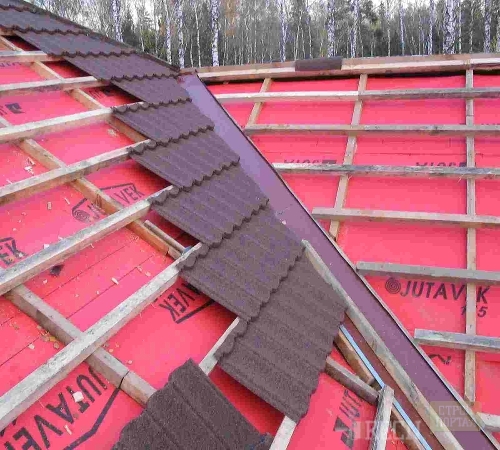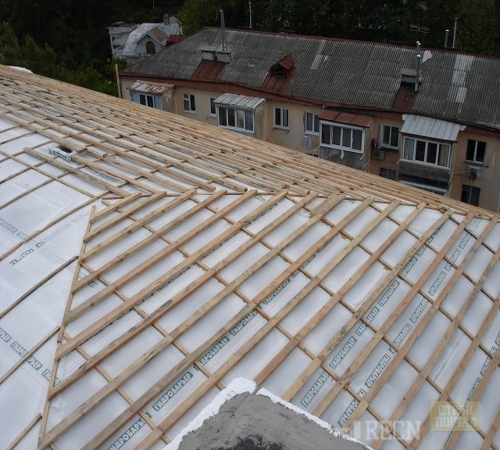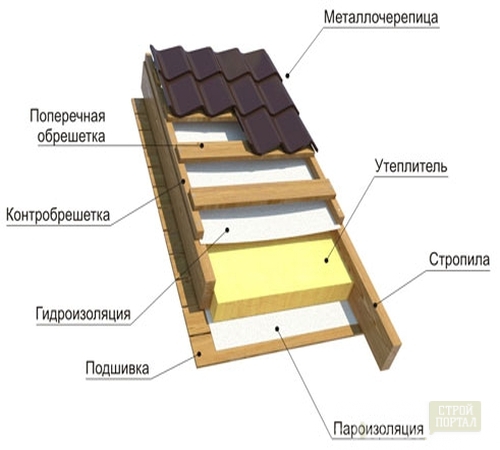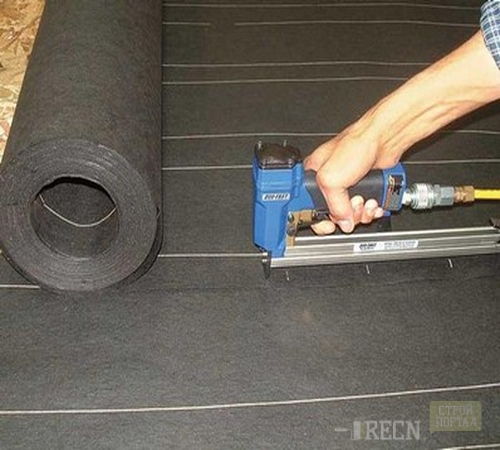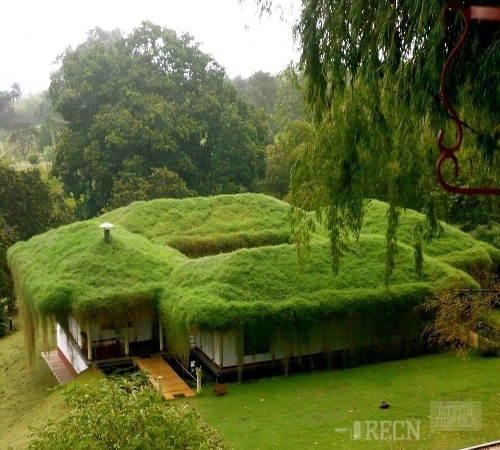
Waterproofing technology roofing Insulation,Construction
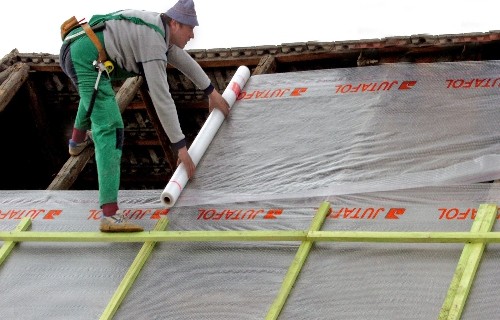
The main task of the roof is the protection of the indoor space of the house from atmospheric precipitation. The technology of mounting roofing materials is certainly important, but only high-quality waterproofing will help completely protect against leaks. And although the process is clearly simple, it requires compliance with clear rules, without which it is impossible to provide complete tightness of the roof.
Content
Choosing materials
Quality work involves the use of materials for waterproofing roofs that are optimally suitable for your type of roof. Allocate the following categories:
- waterproofing films
- polymer membranes (PVC, EPDM, Schipovoid, Super Diffusional),
- hydrophilic rubber
- coolement waterproofing (acrylic, bitumen, silicone, rubber, polyurethane),
- sprayed waterproofing,
- injectable waterproofing, (resin acrylics, polyurethane and silicates, waterproofing cement).
- chemical impregnations.
The easiest option of protection is waterproofing films. They are not expensive, available and easily mounted. Of the disadvantages - are subject to mechanical damage they do not allow one hundred percent protection against moisture.
Polymer membranes look outwardly reminiscent of films, but they are significantly superior to physical properties. Mostly made from PVC. When choosing this material, it should be borne in mind that it is not recommended to use for waterproofing of metal roofs.
Hydrophilic rubber are used as a separate element. They are a ready-made profile that is isolated by various joints and outlet holes (chimney, for example).
Refractory waterproofing are used when installing flat roofs with soft roofing material. Bituminous resins and acrylics solidify long enough (from several hours to two days), so such insulation is simply glazed from the pitched roof.
New-fashioned view - aerosol waterproofing. Using special equipment, the crate (if it is monolithic) or the roofing material is treated with liquid rubber. The material solidifies in a few seconds. As a result, a solid thin layer of rubber on all surfaces is obtained.
Waterproofing roofing, the price of which is highest, is an injection impregnation. It is used only if the roof has non-standard forms and access to places of fitting sheets of roofing material is very difficult. This work is better to entrust professionals.
Chemical impregnations are used for the waterproofing of the crate. This method protects the wooden part of the roof from wetting and rotting, but completely eliminate moisture ingress does not allow.
Preparatory stage
The roof waterproofing device is the work is quite paintaking, so all the details must be thought out in advance. To begin with, we define the type of roof. From this directly depends on the choice of insulating materials and the procedure for performing work. The roof is:
- double
- single,
- flat
- incorrect form.
Two-tight roofs are most often found. For their insulation, you will need a film or membrane and bitumen resin.
A single roof carries a large load. Therefore, in addition to the film, the roofing material is desirable to open the monolithic layer of waterproofing. Aerosol options are suitable.
For flat roofs, only coating waterproofing will be needed. The optimal option bitumen or ordinary resin.
In the roofs of the wrong shape, films, membranes, acrylic, injection waterproofing are used. The seats of adjacent sheets serve as a source of leaks. If sheets converge at an angle, different from 180 0, this place is mandatory must be qualitatively isolated. On the scale of the whole roof, this work is best done with injectable insulators.
In addition, the chemical impregnation is recommended to use in all embodiments. Another important point is to distinguish the inner waterproofing and external. The internal is represented by films and membranes. Water, falling on them, rolls like from the roof itself. But if the flows are too large, the internal insulation will not cope and then water will fall into the attic. For this, there is an external insulation that reduces leaks to a minimum.
Waterproofing technology roofing
Now from theory to practice. By performing roof waterproofing with their own hands, work is divided into the next steps:
- assembly of crates
- insulation
- vaporizoation
- internal waterproofing,
- installation of roofing material
- external waterproofing.
At the stage of assembly, the crates perform chemical protective agents. In the future, this will be done extremely difficult, as access to the tree will be limited.
The insulation is better to use foam or polyurethane foam. They retain warmly, in addition to this, also serve as additional waterproofing.
Vaporizolation must be installed in a mandatory order, otherwise the boards will begin to chart and deteriorate. Even the highest quality chemistry does not protect against this process.
Next, go to the inner waterproofing of the roof. The cost of membranes is more expensive than films. But the protective properties are significantly higher. Mounted both materials completely equally:
- over the crate rolls the roll of isolation about the skate to the eaves,
- roll gradually, every 10 cm fixing the strip by the construction stipode,
- leave a small science (2-3 cm) and trim,
- install the next lane with the first at least 5 cm,
- purchase place to secure the stiplier.
Sometimes the film is proposed to glue, but this does not correspond to technological standards and interferes with a normal air outflow.
Mounting technology roofing depends on its type. But, all the options besides rolled soft coatings, are attached with screws or nails. These parts cut the surface of the film, so the need for outer waterproofing occurs. For roofing work, screws with a rubber gasket under the hat are used, but this precautionary measure cannot fully ensure tightness.
The optimal version of the outer waterproofing is an aerosol spray. Liquid acrylic or bitumen mixtures are used as the basis. The work is performed as follows:
- from the skate to the eaves of the sheets of coating blend with an aerosol mixture,
- the work is performed in the direction from one front to another,
- after applying the first layer, they are waiting for 20-30 minutes,
- next is applied the second layer.
Such a coating creates a transparent hermetic film with a thickness of 0.5 to 2 mm. It is afraid exclusively mechanical damage. In the event that large degrees fall (diameter from 1 cm), it should be updated. Such a layer is enough.
In addition, one or more chimneys are often located on the roof, elements of adjacent geometric structures, attic windows, etc. In order to isolate joints, you will have to be treated with silicone or resin. Silicone has higher hydraulic indicators, but it is exposed to temperature differences. In regions with a continental climate (temperature in summer 30 0 Celsius and more, in winter - below -25 0 Celsius) Silicone just get enough sleep after 2-3 seasons. Therefore, it is better to use bitumen mastic or resin.
The seams are not easy to miss, but you need to plunge the insulator between the surfaces. After the frozen, it will provide a reliable connection that excludes the possibility of leakage.
The process of waterproofing the roof is shown on the video at the end of the article.
Decorative options for outdoor waterproofing
The modern building materials market offers several more options for solving a waterproofing question:
- PVC / bituminous / acrylic fills,
- live roofs.
If we are talking about updating the old roof, which has already been worn out, but the desires and means for overhaul does not sufficiently use liquid roofing coatings.
These materials are solutions similar to paint. They pour straight on the old roof without performing any preparatory work. The coating is obtained monolithic and even. Chemical properties allow the material to "breathe", but he does not miss moisture. This type of waterproofing is the most perfect, but on the scale of construction of a new roof increases the cost of almost twice. Therefore, it is used exclusively for the reconstruction of old roofs.
Another interesting solution is the living roofs. They are:
- based on Derna,
- based on the chernozem.
The first view is a roll coating in which the roots of the grass are tightly intertwined and held the ground. Installation is carried out in two layers. The first is rooted up, the second roots down. This is necessary so that the grass is enough to power. Specially cultured lawns are used in the turf, which is transferred both the effects of the Sun and strong cold. The turf bases do not need irrigation, nor in fertilizers, nor in stopping (to update the grass, the procedure is carried out once a few years, but it is not necessary). The external version of the waterproofing of the roof will tell a photo.
A significantly more economical option is a live roof with a natural lawn. For its installation on the eaves, a fencing is set to 5 cm high. The surface is covered with black soil. It is not recommended to buy land from marsh or lake quarries, as there are many seeds of water plants, and will have to withdraw them for a long time. Chernozem is equalized, and covered with grass seeds. It is advisable to choose the most lively varieties. After 2-3 weeks, the first sprouts will appear on the roof, after a month it will be completely green. Such a lawn must water at least once a week (in winter it is not necessary) and cut as necessary. Naturally, during rains and fogs, there is no need for watering. Alternatively, at the beginning of spring (at a constant temperature +5 0 Celsius and more) on the lawn scatter seeds of annual colors. After a month and a half, the entire roof will be beautifully littered with a multi-colored carpet. Such plants do not need to be removed, they themselves dry and turn into fertilizers for the lawn.




